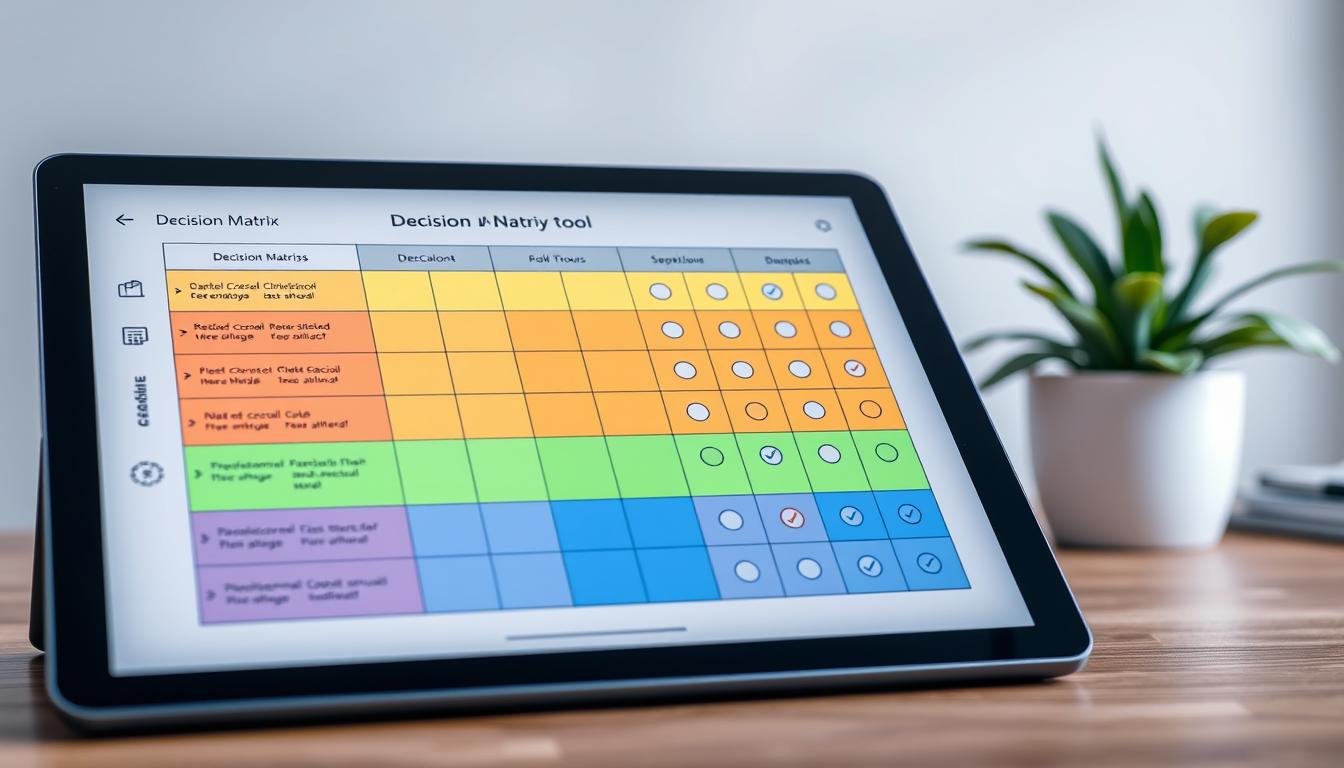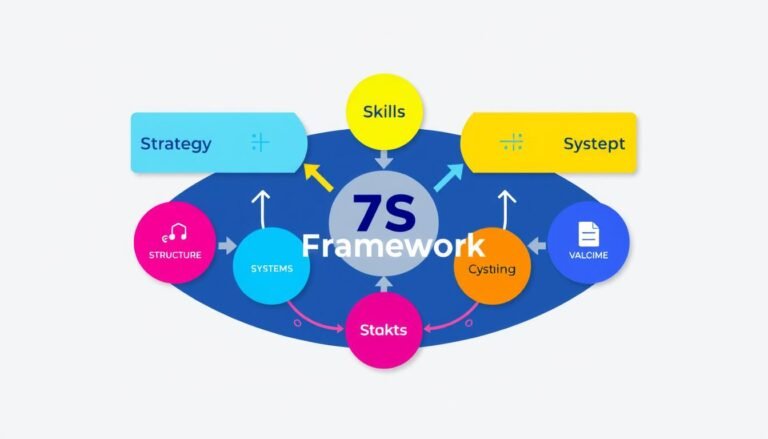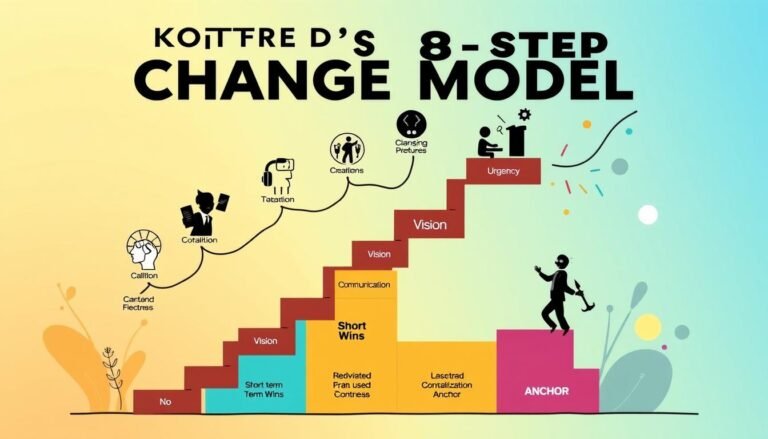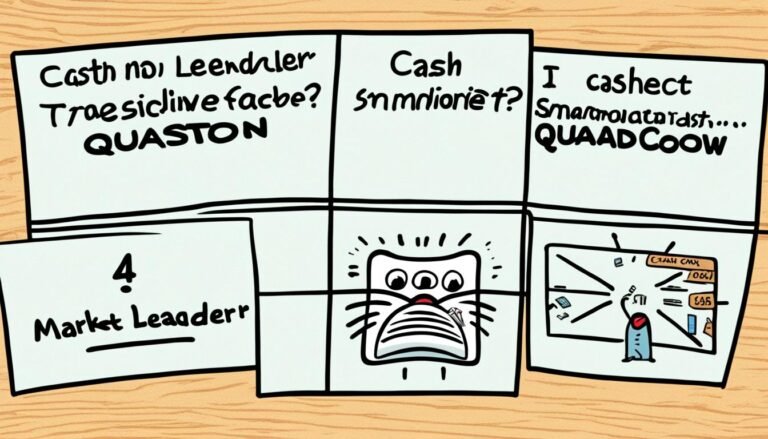Optimize Choices with a Decision Matrix Tool
Have you ever seen some teams make perfect decisions every time? Wondered if there’s a secret to their success? The secret is the Decision Matrix, a powerful tool for making better choices.
In today’s fast world, making smart, unbiased decisions is key. A Decision Matrix helps teams ignore feelings and focus on facts. This tool makes decisions clearer and more in line with the company’s goals. It’s great for picking vendors or deciding on product features.
Key Takeaways
- A Decision Matrix ensures objectivity in the decision-making process.
- It helps clearly outline available options, facilitating effective comparisons.
- The tool quickly eliminates non-viable choices, enabling focused analysis.
- It aids in weighing the pros and cons of each alternative for structured decisions.
- The Decision Matrix is versatile, applicable in various industries and situations.
- By maximizing a team’s capabilities, a decision matrix enables rational choices grounded in evaluated data.
- Utilizing this method promotes logical problem-solving and enhances clarity across decision-making stages.
Introduction to Decision-Making Tools
Decision-making tools are key in making choices better in organizations. Tools like the decision matrix help by making a plan for picking options. They turn complex decisions into a step-by-step process. This ensures choices are made fairly and clearly.
Using these tools helps teams work together better. With a decision matrix, everyone can talk about options in a clear way. This reduces personal opinions and makes it easier to compare different choices.
Some important features of these tools include:
- Weighted decision matrices give more value to some criteria over others.
- They help sum up how well each option meets the criteria, making decisions clearer.
- This structured way of thinking is great for dealing with many options and different factors.
- But, it’s important to think about both personal and objective factors when using them.
For tough decisions, many organizations like the weighted decision matrix. It lets you set the importance of different criteria. This method works in many areas, from managing products to making personal choices. With a decision matrix, decision-makers can weigh and pick the best options confidently.
What is a Decision Matrix
A decision matrix is a key tool for making structured decisions. It helps people and teams look at options based on certain criteria. This method makes sure decisions are logical and fair.
Definition and Purpose
The Decision Matrix Definition is all about being a Prioritization Matrix or a weighted scoring model. It lets users look at and rank different options with clear criteria. By setting a value on each factor, it fights bias and leads to smart choices. This is very useful in complex situations where many things affect the outcome.
Common Names and Variants
People call it by many names, like grid analysis and Pugh Matrix. It can also be seen as multi-attribute utility theory. Each version has its own way of helping with decisions, but they all aim to make things clearer and easier to evaluate. Knowing these names helps people pick the best method for their needs.
Benefits of Using a Decision Matrix Tool
The decision matrix tool offers many advantages that help in making decisions. It makes the decision-making process better. This makes it a key tool for decision support.
Ensures Objectivity in Decision-Making
Using a decision matrix helps make decisions more objective. It turns complex problems into simple numbers. This way, decisions are based on facts, not feelings.
This method reduces the impact of personal opinions. It helps avoid decisions influenced by personal biases.
Facilitates Comparisons Across Multiple Options
A decision matrix makes it easy to compare different choices. It uses a clear structure to help see what matters most. This makes it quick to find the best option.
It helps sort and rank choices clearly. This is key when picking the best from many options.
Enhances Clarity and Structure
A decision matrix makes decisions clear and organized. It lists criteria, weights, and scores clearly. This helps teams talk about decisions with ease.
This method ensures decisions are well-supported and clear. It helps everyone see why certain choices are made.
| Benefits | Description |
|---|---|
| Objectivity | Minimizes biases and promotes rational decisions through quantification. |
| Comparison | Enables structured comparisons across multiple options, allowing for quick elimination of less viable choices. |
| Clarity | Provides clear documentation of criteria, weights, and scores, fostering transparent discussions. |
Key Components of a Decision Matrix
A decision matrix works best with key parts like criteria for checking, options, and a way to score them. Knowing these parts helps make decisions clearer and more structured.
Criteria for Evaluation
Evaluation criteria are the base for comparing choices in a decision matrix. They cover things like cost, quality, and if it’s possible to do. It’s important to look at both the good and bad sides of each choice.
Options/Alternatives
Options are the different choices in the decision matrix. It’s key to list all possible choices to make sure each one is checked against the criteria. This makes the decision-making process more thorough and informed.
Weighting and Scoring Explained
Weighting means saying how important each criterion is in making a decision. Then, each option gets a score based on these criteria. This scoring helps compare options by giving a number to how well they do.
By multiplying scores with their weights, the decision matrix shows the best option that meets the goals.
| Component | Description | Example |
|---|---|---|
| Criteria | Factors for evaluating options | Cost, Quality, Time |
| Options | The various choices evaluated | Product A, Product B, Product C |
| Weighting | Importance assigned to each criterion | Cost: 40%, Quality: 30%, Time: 30% |
| Scoring | Quantification of how well options meet criteria | 1-10 scale or Low, Medium, High |
How to Create a Decision Matrix
Creating a decision matrix is a step-by-step process that helps make decisions easier. It breaks down complex choices into clear steps. This guide will show you how to create a decision matrix for your needs. It helps teams look at many options and choose the best ones based on important factors.
Step-by-Step Guide to Building the Matrix
First, define the decision you need to make. Knowing the context is key to making a good matrix. Then, decide on the criteria for evaluating options. It’s best to keep it to five alternatives to stay focused.
- List Options: Start with a list of possible choices.
- Assign Weights: Give each criterion a weight based on its importance to the decision.
- Score Each Option: Rate how well each option meets the criteria using a scale like one to five.
- Calculate Weighted Scores: Multiply the scores by their weights to get the total score for each option.
This method helps you evaluate options logically. It makes sure you consider all important factors when deciding.
Practical Example of a Decision Matrix in Use
Let’s say a team needs to pick a vendor for a project. They list potential suppliers against criteria like reliability, cost, and expertise. They score each vendor on these criteria. Then, they use weighted ratings to show which vendor is best based on total scores.
| Vendor | Reliability (1-5) | Cost (1-5) | Expertise (1-5) | Total Score |
|---|---|---|---|---|
| Vendor A | 4 | 3 | 5 | 56 |
| Vendor B | 3 | 4 | 3 | 40 |
| Vendor C | 5 | 3 | 4 | 55 |
| Vendor D | 4 | 5 | 2 | 50 |
This example shows how a decision matrix helps a team make smart, data-based choices. It focuses on clear criteria, reducing emotional decisions. This leads to better teamwork in making decisions.
Applications of Decision-Matrix in Real-World Scenarios
Decision matrices are key in many areas, helping with structured decision-making. They are useful in both work and personal life. Here are some main areas where they show their value.
Product Management and Feature Prioritization
In Product Management, decision matrices are crucial for picking which features to focus on. They look at things like how much customers want it, how hard it is to make, and how much money it will make. This helps teams pick the best projects. For instance, a team might use a matrix to score features like “User Analytics,” “Mobile Responsiveness,” and “API Development” against certain criteria.
Choosing a Vendor or Service Provider
Decision matrices make picking a vendor easier for businesses. They set up criteria like cost, quality, and reliability. By weighing these factors, companies can make choices based on what matters most. This method helps compare options clearly, making it easier to find a good match for the company’s needs.
Personal Decision-Making Examples
Decision matrices also help with personal choices. For example, someone might use one to pick a vacation spot. They would look at things like cost, weather, and activities. By scoring each place against these, they can choose wisely, keeping in mind their budget and what they like to do.
| Application Area | Key Criteria | Example Options |
|---|---|---|
| Product Management | Customer Demand, Development Effort, ROI | User Analytics, Mobile Responsiveness, API Development |
| Vendor Selection | Cost, Service Quality, Reliability | Vendor A, Vendor B, Vendor C |
| Personal Decisions | Cost, Climate, Activities | Destination X, Destination Y, Destination Z |
Conclusion
The decision matrix is a powerful tool for making better decisions in many areas. It helps by making decisions clear and objective. This makes it very useful for both companies and individuals.
With a decision matrix, teams can handle tough choices better. They make sure their decisions are well-thought-out and logical. This tool is great for many areas like managing projects, picking vendors, and hiring people.
Tools like Venngage offer customizable templates. These templates help in making these comparisons clear. This makes the decision-making process more transparent.
In short, the decision matrix boosts productivity by helping people focus on what’s important. It makes decisions faster and more informed. In conclusion, the decision matrix is a key part of modern decision-making tools. It’s crucial for getting the best results.
Source Links
- A Basic Guide to Using a Decision Matrix | SafetyCulture
- Weighted Decision Matrix: A Tool for Pro-level Prioritization
- The Decision Matrix ➟ easy explained | 4strat
- 7 Quick Steps to Create a Decision Matrix, with Examples [2024] • Asana
- Decision-Making and Criteria
- What is a Decision Matrix? How to Use One for Your Business
- What is a Decision Matrix, and How Can We Use it? | Simplilearn
- What Is a Decision Matrix? (Example & Template Included)
- What are the benefits and drawbacks of a decision matrix?
- Pros and Cons of a Decision Matrix · ActiveCollab Blog
- How To Use a Decision Matrix For Your Business
- What is a Decision Matrix and How to Use it? | Creately
- Decision matrix analysis: A complete guide – forms.app
- Bricks | How to Create an Effective Decision Matrix
- How To Create A Decision Matrix + Example & Free Template
- Decision Matrix
- 7 Simple Steps to Create a Decision Matrix with Templates for Success – Project Management Report
- Leverage Decision Matrix for Informed Choices | Wrike
- What is a decision matrix? Templates, examples, and types – LogRocket Blog
- Use Decision Matrix to Assist Business Decision Making – Venngage
- Weighted Decision Matrix | Lucidspark
- What’s New in PMBOK 6th Edition







